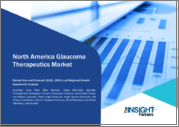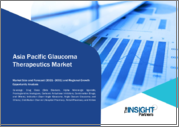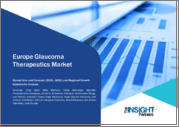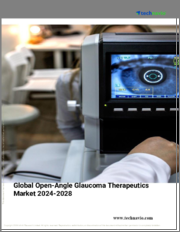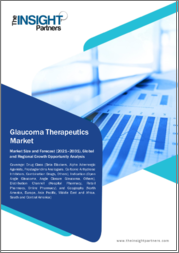
|
시장보고서
상품코드
1800891
녹내장 치료 시장 보고서 : 약제 클래스별, 적응증별, 최종사용자별, 지역별(2025-2033년)Glaucoma Therapeutics Market Report by Drug Class, Indication, End User, and Region 2025-2033 |
||||||
세계 녹내장 치료 시장 규모는 2024년 84억 달러에 달했습니다. IMARC Group은 2033년에는 141억 달러에 달하고, 2025-2033년 연평균 성장률(CAGR)은 5.35%를 보일 것으로 예측했습니다. 북미가 현재 시장을 선도하고 있는 배경에는 높은 수준의 의료 인프라, 높은 인지도, 첨단 치료 접근성, 강력한 규제 지원, 녹내장 위험에 노출된 고령 인구가 많다는 점 등이 있습니다. 전 세계 녹내장 유병률 증가, 조기 발견을 위한 진단 기술의 지속적인 발전, 안과에서 원격 의료의 채택 증가, 수술의 수많은 기술 혁신은 시장을 주도하는 요인 중 일부입니다.
녹내장은 전 세계적으로 영구적인 실명의 원인으로 꼽히는 질환으로 매년 진단받는 환자 수가 증가하고 있습니다. 이 질환은 일반적으로 무증상으로 서서히 진행되기 때문에 조기 발견이 어렵고 지속적인 치료가 필요한 환자 수가 많아 녹내장 치료 시장이 확대되고 있습니다. 또한, 녹내장에 대한 사회적 인식 개선과 교육 개선으로 더 많은 사람들이 검진을 받게 되어 조기 발견으로 이어지고 있습니다. 조기 개입은 환자가 실질적인 시신경 손상을 입기 전에 질병을 통제하는 것을 목표로 하기 때문에 치료 수요가 증가하여 시장 성장을 뒷받침하고 있습니다. 이와 더불어, 제약회사 및 의료기관의 연구 사업 자금 지원 증가는 시신경 건강 유지에 초점을 맞춘 신경 보호 치료와 같은 새로운 치료법을 찾아내는데 기여하고 있습니다. 이러한 기술 혁신에 대한 강조는 치료의 선택지를 늘리고, 이를 통해 시장 선택의 폭을 넓혀 환자들에게 녹내장을 효과적으로 관리할 수 있는 새로운 낙관론을 가져다주고 있습니다.
녹내장 치료제 시장 동향과 촉진요인:
수술 기법의 발전
수술 기술의 발전, 특히 최소침습녹내장수술(MIGS)의 등장으로 녹내장 치료 시장에 영향을 미치고 있습니다. MIGS는 기존 수술과 달리 합병증 감소, 회복기간 단축, 시술 간소화 등 보다 안전한 옵션을 제공함으로써 녹내장 치료에 혁명을 일으키고 있습니다. 이 발전은 외과의사에게 새로운 치료 옵션을 제공하는 동시에 환자의 위험과 불편함을 줄일 수 있습니다. 또한, 마이크로 스텐트 및 혁신적인 배액 시스템을 포함한 수술기구의 개발로 녹내장 수술의 효율성이 향상되고 있습니다. 기술 혁신의 중요한 예로는 2025년 미국에서 출시된 알콘의 Voyager(TM) DSLT를 들 수 있습니다. 이것은 최초의 완전 자동 Direct Selective Laser Trabeculoplasty 장비입니다. 이 장비는 고니오 렌즈나 수동 타겟팅이 필요 없이 120개의 레이저 펄스를 제공하여 SLT 프로세스를 간소화하고 정확도를 높이며 시술의 복잡성을 최소화합니다. 이러한 기술 혁신은 수술에 대한 신뢰를 높이고, 시장 확대와 치료 결과의 향상을 촉진합니다.
제네릭 의약품의 성장
녹내장 치료용 제네릭 의약품 증가로 비용 효율적인 치료에 대한 접근성이 증가하고 있습니다. 프로스타글란딘 유사체와 같은 유명한 녹내장 치료제의 제네릭 의약품은 그 효능을 유지하면서 유명 브랜드 치료제를 대체할 수 있는 경제적인 치료제를 제공합니다. 이러한 추세는 특히 경제적 제약이나 보험 적용의 한계에 직면할 수 있는 환자들의 치료 접근성을 향상시키는 데 필수적입니다. 제네릭 의약품은 의료비 절감에 기여하는 동시에 더 많은 환자층이 녹내장의 효과적인 치료를 받을 수 있게 해줍니다. 유명 의약품의 제네릭 의약품을 출시하는 제약사가 증가함에 따라 경쟁이 치열해지면서 가격 하락과 시장 접근성 확대가 이루어지고 있습니다. 2024년 미국 글렌마크 파마슈티컬스는 녹내장 및 안구건조증 치료제 트라바탄 Z-트라보프로스트 점안액 0.004% 제네릭 의약품을 출시했습니다. 이 제품은 샌드의 기준약과 생물학적으로 동등하며, 글렌마크의 안과 제품 포트폴리오를 확장하는 제품입니다. Trabatan Z는 2024년 9월 현재 미국에서 연간 6,620만 달러의 매출을 기록하고 있습니다.
유전자 치료의 발전
최근 유전자 치료의 발전은 이 질병에 대처할 수 있는 새롭고 독창적인 방법을 제공합니다. 과학자들은 망막 신경절 세포를 보호하고 미토콘드리아 기능을 개선하는 등 녹내장의 근본 원인을 해결하기 위한 유전자 치료법을 연구하고 있습니다. 특정 유전자를 눈에 도입하는 이 치료법은 안압을 낮추는 동시에 시신경의 완전성을 보호하고 시각 관련 세포의 전반적인 기능을 향상시키는 것을 목표로 합니다. 임상시험에서 유전자 치료의 발전으로 유전자 치료는 기존 치료의 유망한 대안으로 부상하고 있으며, 부작용을 줄이면서 지속적인 이점을 제공할 수 있는 잠재력을 가지고 있습니다. 이러한 첨단 치료법의 개발은 환자들에게 보다 정확하고 효율적인 녹내장 관리 옵션을 제공함으로써 시장 확대를 촉진하고 상당한 투자와 주목을 받고 있습니다. 2024년 더블린 트리니티 칼리지 연구진은 망막 신경절 세포를 보호하고 미토콘드리아 기능을 강화하는 획기적인 녹내장 유전자 치료법을 발표했습니다. AAV로 eNdi1 유전자를 도입한 이 치료법은 동물 모델과 인간 모델에서 시각 관련 세포의 성능을 향상시켰습니다. 스핀아웃한 Vzarii Therapeutics는 이 치료법을 임상시험으로 발전시키기 위해 설립되었습니다.
녹내장 치료제 시장 성장 촉진요인:
노인 인구 증가
세계 노인 인구 증가, 특히 선진국과 급속한 개발도상국의 노인 인구 증가는 녹내장 환자의 대폭적인 증가로 이어지고 있습니다. 세계보건기구(WHO)는 2030년까지 전 세계 6명 중 1명이 60세 이상이 될 것으로 추정하고 있으며, 이 수치는 2050년까지 두 배인 21억 명에 이를 것으로 예측했습니다. 이러한 인구통계학적 변화로 인해 녹내장에 취약한 환자 수가 증가하면서 효과적인 진단 방법, 대체 치료법, 지속적인 관리 접근법의 필요성이 높아지고 있습니다. 노인들은 녹내장과 같은 장기적인 질병에 걸리기 쉽고, 시력 장애를 피하기 위해 지속적인 치료가 필요한 경우가 많습니다. 따라서 노인 인구 증가로 인해 내과적 및 외과적 치료법을 포함한 새로운 치료법에 대한 수요가 증가하고 있습니다. 이러한 추세는 고령 환자들의 특수한 요구 사항을 충족하는 맞춤형 치료법을 개발하기 위한 연구 사업에 대한 투자를 촉진하여 시장 성장을 더욱 촉진하고 있습니다.
인식 제고와 조기 진단
녹내장에 대한 인식 개선은 녹내장 치료제 시장 확대에 있어 매우 중요합니다. 건강 캠페인, 안과 의료기관의 노력, 정보 접근성 향상 등이 녹내장 인식 개선에 기여하고 있습니다. 조기 발견의 중요성에 대한 인식이 높아지면서 정기적인 안과 검진에 대한 수요가 증가하고 있으며, 특히 고위험군에 대한 수요가 증가하고 있습니다. 조기 진단을 통해 적시에 개입할 수 있어 돌이킬 수 없는 시력 손실의 위험을 줄이고 치료 결과를 개선할 수 있습니다. 2024년, 아비인디아와 Sightsavers India는 40세 이상의 사람들을 대상으로 15개월간 녹내장에 대한 인식을 높이기 위한 캠페인을 시작했습니다. 이 캠페인은 조기 진단과 치료를 장려하기 위해 스크리닝 캠프, 온라인 지원 활동, 교육 프로그램 등을 진행했습니다. 이러한 적극적 의료 서비스로의 전환은 녹내장 치료, 진단 도구, 수술적 치료에 대한 수요 증가로 이어집니다. 그 결과, 인식 개선이 녹내장 치료제의 채택을 직접적으로 촉진하고 있습니다.
약물 전달 시스템의 발전
서방형 임플란트, 펑크 플러그, 주사제 등의 기술 혁신은 녹내장 치료의 투여 방법을 바꾸고 있습니다. 이 혁신적인 시스템은 정기적인 안약 점안이 필요하고 환자의 복약 순응도가 떨어지는 기존 점안제보다 더 오래 지속되는 효과를 제공합니다. 예를 들어, 서방형 제제는 몇 주에서 몇 달 동안 약효가 지속될 수 있어 매일 점안할 필요성을 최소화하고 치료 순응도를 향상시킬 수 있습니다. 이는 환자의 편안함을 향상시킬 뿐만 아니라 균일한 치료 결과를 보장하고 궁극적으로 우수한 안압 조절을 가져옵니다. 약물 전달 시스템의 강화가 강조되면서 보다 정교한 녹내장 치료제에 대한 수요가 증가하고 있습니다. 2024년, 리플 테라퓨틱스는 녹내장 안압을 낮추기 위한 완전 생분해성 서방형 방광 내 임플란트 RTC-620을 개발하기 위해 AbbVie와 공동연구를 발표하였습니다. 리플이 전임상 개발을 담당하고, 애브비가 임상시험과 상용화를 주도합니다. 이 임플란트는 폴리머나 부형제를 사용하지 않고 반복 투여가 가능하며, 염증 위험을 줄여줍니다.
목차
제1장 서문
제2장 조사 범위와 조사 방법
- 조사 목적
- 이해관계자
- 데이터 소스
- 1차 정보
- 2차 정보
- 시장 추정
- 보텀업 접근
- 톱다운 접근
- 조사 방법
제3장 주요 요약
제4장 서론
제5장 세계의 녹내장 치료 시장
- 시장 개요
- 시장 실적
- COVID-19의 영향
- 시장 예측
제6장 시장 분석 : 약제 클래스별
- 프로스타글라딘 유사체
- 베타 차단제
- 알파 아드레날린 작용제
- 탄산탈수효소 억제제
- 복합제제
- 기타
제7장 시장 분석 : 적응증별
- 개방각 녹내장
- 폐쇄각 녹내장
- 기타
제8장 시장 분석 : 최종사용자별
- 병원
- 안과 클리닉
- 외래수술센터(ASC)
- 기타
제9장 시장 분석 : 지역별
- 북미
- 미국
- 캐나다
- 아시아태평양
- 중국
- 일본
- 인도
- 한국
- 호주
- 인도네시아
- 기타
- 유럽
- 독일
- 프랑스
- 영국
- 이탈리아
- 스페인
- 러시아
- 기타
- 라틴아메리카
- 브라질
- 멕시코
- 기타
- 중동 및 아프리카
제10장 SWOT 분석
제11장 밸류체인 분석
제12장 Porter의 Five Forces 분석
제13장 가격 분석
제14장 경쟁 구도
- 시장 구조
- 주요 기업
- 주요 기업 개요
- Aerie Pharmaceuticals Inc.
- Allergan Plc
- Bausch & Lomb Incorporated(Bausch Health Companies Inc.)
- Inotek Pharmaceuticals Corp.
- Merck & Co. Inc.
- Novartis AG
- Pfizer Inc.
- Santen Pharmaceutical Co. Ltd.
- SIFI S.p.A
- Teva Pharmaceutical Industries Ltd.
The global glaucoma therapeutics market size reached USD 8.4 Billion in 2024. Looking forward, IMARC Group expects the market to reach USD 14.1 Billion by 2033, exhibiting a growth rate (CAGR) of 5.35% during 2025-2033. North America currently leads the market because of advanced healthcare infrastructure, increasing awareness, access to cutting-edge treatments, strong regulatory support, and a large aging population at risk for glaucoma. The growing prevalence of glaucoma across the globe, continual advancements in diagnostic technologies for early detection, the rising adoption of telemedicine in ophthalmology, and numerous technological innovations in surgical procedures represent some of the factors that are propelling the market.
Glaucoma ranks among the top causes of permanent blindness globally, with a growing number of individuals being diagnosed annually. The condition typically advances gradually and asymptomatically, complicating early detection and resulting in a larger group of patients needing continuous therapeutic care, thereby broadening the market for glaucoma treatments. Moreover, increasing public awareness initiatives and better education regarding glaucoma are motivating more individuals to undergo screenings, resulting in earlier detections. Earlier intervention leads to an increase in the need for therapeutic treatments as patients aim to control the disease prior to substantial optic nerve damage, supporting the market growth. Besides this, heightened funding from pharmaceutical firms and healthcare institutions in research operations is leading to the identification of new therapies, including neuroprotective treatments focused on maintaining optic nerve health. This emphasis on innovation leads to additional treatment choices, thereby broadening the market offerings and providing patients with renewed optimism for effectively managing glaucoma.
Glaucoma Therapeutics Market Trends/Drivers:
Advancements in Surgical Procedures
Advancements in surgical technology are influencing the glaucoma therapeutics market, especially with the emergence of minimally invasive glaucoma surgeries (MIGS). MIGS is revolutionizing the treatment of glaucoma by providing safer alternatives with reduced complications, quicker recovery periods, and simpler procedures in contrast to conventional surgeries. This advancement provides surgeons with additional treatment options while reducing risks and discomfort for patients. Moreover, developments in surgical instruments, including micro-stents and innovative drainage systems, are improving the effectiveness of glaucoma surgeries. A significant instance of innovation is the 2025 introduction of Alcon's Voyager(TM) DSLT in the US, the initial fully automated Direct Selective Laser Trabeculoplasty apparatus. This instrument streamlines the SLT process by providing 120 laser pulses without requiring a gonio lens or manual targeting, enhancing accuracy and minimizing procedural intricacy. These technological innovations enhance trust in surgical procedures, boosting market expansion and enhancing treatment results.
Growth of Generic Drugs
The increasing availability of generic glaucoma drugs is providing more access to cost-effective therapies. Generic forms of well-known glaucoma medications, like prostaglandin analogs, offer an economical substitute to name-brand treatments while maintaining their effectiveness. This trend is essential for increasing access to treatment, especially for patients who might face financial limitations or restrictions in insurance coverage. Generic medications contribute to lower healthcare expenses while allowing a wider patient demographic to gain access to effective treatments for glaucoma. With the rise of pharmaceutical companies launching generic versions of well-known medications, competition intensifies, leading to lower prices and broader market access. In 2024, Glenmark Pharmaceuticals Inc., USA launched a generic version of Travatan Z-Travoprost ophthalmic solution 0.004%-for treating glaucoma and ocular hypertension. The product is bioequivalent to Sandoz's reference drug and expands Glenmark's ophthalmic portfolio. Travatan Z recorded $66.2 million in annual U.S. sales as of September 2024.
Advancements in Gene Therapy
Recent advancements in gene therapy are providing novel, creative methods for addressing the condition. Scientists are investigating gene therapies aimed at addressing the root causes of glaucoma, such as the protection of retinal ganglion cells and the improvement of mitochondrial functions. These treatments, which involve introducing particular genes to the eye, seek to reduce intraocular pressure while also protecting optic nerve integrity and enhancing the overall function of vision-related cells. With the advancement of gene therapy in clinical trials, it emerges as a hopeful substitute for conventional treatments and may provide lasting advantages with reduced side effects. The creation of these advanced treatments is drawing considerable investment and focus, driving market expansion by offering patients more precise, efficient choices for controlling glaucoma. In 2024, Trinity College Dublin researchers announced a breakthrough gene therapy for glaucoma that protects retinal ganglion cells and enhances mitochondrial function. The therapy, using an AAV-delivered eNdi1 gene, improved vision-related cell performance in animal and human models. A spinout, Vzarii Therapeutics, was formed to advance it toward clinical trials.
Glaucoma Therapeutics Market Growth Drivers:
Growing Geriatric Population
The increasing elderly population worldwide, especially in advanced and swiftly developing nations, is leading to a significant rise in glaucoma cases. The World Health Organization (WHO) estimates that by 2030, one in every six individuals globally will be 60 years or older, a figure anticipated to double by 2050, hitting 2.1 billion. This demographic change is expanding the number of patients vulnerable to glaucoma, leading to a growing need for effective diagnostic methods, treatment alternatives, and continuous management approaches. Senior individuals are more vulnerable to long-term ailments such as glaucoma, which frequently necessitates ongoing treatment to avert vision impairment. Therefore, the rising number of elderly individuals is driving the demand for new treatments, including both medical and surgical options. This trend is encouraging investment in research operations to formulate customized therapies that meet the unique requirements of elderly patients, further bolstering the market growth.
Rising Awareness and Early Diagnosis
Raising awareness regarding glaucoma is crucial for stimulating the expansion of the glaucoma therapeutics market. Health campaigns, efforts by eye-care organizations, and greater information accessibility are all helping to raise awareness about the condition. With an increasing number of people recognizing the significance of early detection, there is a rise in the demand for routine eye examinations, especially among high-risk groups. Early diagnosis allows for timely intervention, reducing the risk of irreversible vision loss and ensuring better treatment outcomes. In 2024, AbbVie India and Sightsavers India initiated a 15-month campaign to raise awareness about glaucoma, focusing on people aged 40 and older. The initiative featured screening camps, online outreach, and educational programs to encourage early diagnosis and treatment. This shift towards proactive healthcare leads to higher demand for glaucoma medications, diagnostic tools, and surgical treatments. As a result, greater awareness is directly driving the adoption of glaucoma therapies.
Advancements in Drug Delivery Systems
Innovations, such as sustained-release implants, punctal plugs, and injectable formulations, are changing how glaucoma treatments are delivered. These innovative systems offer a more enduring effect than conventional eye drops, which necessitate regular application, frequently resulting in insufficient patient adherence. Sustained-release systems, for instance, can provide medication for weeks or even months, minimizing the necessity for daily administration and enhancing treatment compliance. This not only improves patient comfort but also guarantees uniform therapeutic outcomes, ultimately resulting in superior management of intraocular pressure. The heightened emphasis on enhancing drug delivery systems is catalyzing the demand for more sophisticated glaucoma therapies. In 2024, Ripple Therapeutics announced a collaboration with AbbVie to develop RTC-620, a fully biodegradable sustained-release intracameral implant for reducing intraocular pressure in glaucoma. Ripple will handle preclinical development, while AbbVie will lead clinical trials and commercialization. The implant allowed repeat dosing without polymers or excipients, reducing inflammation risk.
Glaucoma Therapeutics Industry Segmentation:
Breakup by Drug Class:
- Prostaglandin Analogs
- Beta Blockers
- Alpha Adrenergic Agonists
- Carbonic Anhydrase Inhibitors
- Combination Drugs
- Others
Prostaglandin analogs represents the largest market segment
The prostaglandin analogs segment in the market is predominantly driven by their efficacy in reducing intraocular pressure with fewer systemic side effects compared to other classes of glaucoma medications. The once-daily dosing convenience of these drugs also contributes to patient compliance, thereby increasing its market demand. Innovation in formulations and delivery mechanisms is another major factor contributing to its market share. Intellectual property expiry and subsequent entry of generics, however, pose a challenge to market growth. Lastly, their versatile compatibility with other classes of glaucoma medications makes them a preferred choice in combination therapies, bolstering the segment's prominence.
On the other hand, the beta blockers, alpha adrenergic agonists, carbonic anhydrase inhibitors, combination drugs and other segments are influenced by a diverse range of factors such as affordability, varied mechanisms of action, and well-established safety profiles. These drugs are often prescribed in cases where Prostaglandin Analogs are contraindicated or not effective. Despite their efficacy, the need for multiple daily dosing can impact patient compliance. Availability of generics in this category also makes it a cost-effective option for treatment.
Breakup by Indication:
- Open Angle Glaucoma
- Angle Closure Glaucoma
- Others
Open angle glaucoma represents the largest market segment
The open-angle glaucoma segment is primarily fueled by its prevalence, constituting the majority of glaucoma cases globally. Increased awareness and advancements in diagnostic techniques have led to earlier and more frequent detection of this condition. The availability of multiple treatment options, ranging from medications to surgeries, offers a comprehensive approach to managing open-angle glaucoma. Aging demographics further amplify the incidence rates, thereby driving glaucoma therapeutics market demand. Government initiatives aimed at eye health contribute to the overall market growth for this segment.
On the other hand, the growth in angle closure glaucoma and other segments is primarily driven by an aging population, as the condition is more prevalent among older adults. Advances in diagnostic technologies have also contributed to the segment's expansion by enabling earlier and more accurate detection of the condition. In addition, the increased awareness about the severity of untreated angle-closure glaucoma, which can lead to blindness, has led to higher demand for effective treatments.
Breakup by End User:
- Hospitals
- Ophthalmic Clinics
- Ambulatory Surgery Centers
- Others
Hospitals accounts for the majority of the market share
Hospitals are major consumers in the glaucoma therapeutics market, given their capability to offer advanced diagnostic and surgical interventions. The consolidation of healthcare facilities and investment in state-of-the-art ophthalmic departments contribute to the segment's growth. Additionally, hospitals are often the first point of contact for emergency eye conditions, thereby positioning them as crucial stakeholders. Public and private insurance coverages also incentivize treatment in hospital settings, increasing patient throughput and consumption of glaucoma medications.
On the other hand, the growth in ophthalmic clinics, ambulatory surgery centers, and other segments can be attributed to the specialized focus on eye care, the availability of advanced diagnostic equipment, and faster patient turnover. Increasing consumer preference for specialized care is also a contributing factor. Decentralization of healthcare services and the expansion of ambulatory surgery centers make these settings accessible for minor procedures and regular check-ups. The growth is further supported by flexible payment options and shorter waiting times.
Breakup by Region:
- North America
- United States
- Canada
- Asia Pacific
- China
- Japan
- India
- South Korea
- Australia
- Indonesia
- Others
- Europe
- Germany
- France
- United Kingdom
- Italy
- Spain
- Russia
- Others
- Latin America
- Brazil
- Mexico
- Others
- Middle East and Africa
North America exhibits a clear dominance, accounting for the largest glaucoma therapeutics market share
The glaucoma therapeutics market research report has also provided a comprehensive analysis of all the major regional markets, which include North America (the United States and Canada); Asia Pacific (China, Japan, India, South Korea, Australia, Indonesia, and others); Europe (Germany, France, the United Kingdom, Italy, Spain, Russia, and others); Latin America (Brazil, Mexico, and others); and the Middle East and Africa. According to the report, North America accounted for the largest market share.
The market in the North America region is significantly impelled by high healthcare expenditure, robust insurance frameworks, and the presence of leading pharmaceutical companies are primary drivers. Furthermore, the region is home to a diverse and aging population, thereby creating a natural demand for glaucoma treatments. Technological advancements in drug formulation and delivery, backed by substantial investments in research and development, also fuel glaucoma therapeutics market growth.
Regulatory support in terms of expedited approvals and grants fosters innovation, providing a favorable environment for market expansion. Government initiatives in healthcare education and eye screenings contribute to early diagnosis and, in turn, drive demand for therapeutics. Accessibility to specialty ophthalmic clinics and ambulatory surgery centers adds another layer of convenience, encouraging timely intervention.
The availability of both branded and generic drugs offers options across various price points, catering to a wide consumer base. Furthermore, collaborations between public and private sectors in healthcare initiatives serve to increase awareness as well as facilitate entry and acceptance of novel therapeutic solutions in the market.
Competitive Landscape:
The major players in the market are persistently working to develop more effective and less invasive treatment options. They are investing heavily in clinical trials to produce medicines and devices that provide longer-lasting relief with fewer side effects. Collaborations with research institutions and healthcare organizations are common strategies these key players are adopting. Market leaders are also expanding their portfolios by launching innovative products specifically designed to manage different types of glaucoma. Furthermore, these companies are working diligently to meet stringent regulatory requirements, ensuring that their products are both safe and effective. Furthermore, they are also focusing on patient education and awareness programs as a part of their market expansion strategies, thereby offering a favorable glaucoma therapeutics market outlook.
The report has provided a comprehensive analysis of the competitive landscape in the market. Detailed profiles of all major companies have also been provided. Some of the key players in the market include:
- Aerie Pharmaceuticals Inc.
- Allergan Plc
- Bausch & Lomb Incorporated (Bausch Health Companies Inc.)
- Inotek Pharmaceuticals Corp.
- Merck & Co. Inc.
- Novartis AG
- Pfizer Inc.
- Santen Pharmaceutical Co. Ltd.
- SIFI S.p.A
- Teva Pharmaceutical Industries Ltd
Key Questions Answered in This Report
- 1.How big is the global glaucoma therapeutics market?
- 2.What is the expected growth rate of the global glaucoma therapeutics market during 2025-2033?
- 3.What are the key factors driving the global glaucoma therapeutics market?
- 4.What has been the impact of COVID-19 on the global glaucoma therapeutics market?
- 5.What is the breakup of the global glaucoma therapeutics market based on the drug class?
- 6.What is the breakup of the global glaucoma therapeutics market based on the indication?
- 7.What is the breakup of the global glaucoma therapeutics market based on the end user?
- 8.What are the key regions in the global glaucoma therapeutics market?
- 9.Who are the key players/companies in the global glaucoma therapeutics market?
Table of Contents
1 Preface
2 Scope and Methodology
- 2.1 Objectives of the Study
- 2.2 Stakeholders
- 2.3 Data Sources
- 2.3.1 Primary Sources
- 2.3.2 Secondary Sources
- 2.4 Market Estimation
- 2.4.1 Bottom-Up Approach
- 2.4.2 Top-Down Approach
- 2.5 Forecasting Methodology
3 Executive Summary
4 Introduction
- 4.1 Overview
- 4.2 Key Industry Trends
5 Global Glaucoma Therapeutics Market
- 5.1 Market Overview
- 5.2 Market Performance
- 5.3 Impact of COVID-19
- 5.4 Market Forecast
6 Market Breakup by Drug Class
- 6.1 Prostaglandin Analogs
- 6.1.1 Market Trends
- 6.1.2 Market Forecast
- 6.2 Beta Blockers
- 6.2.1 Market Trends
- 6.2.2 Market Forecast
- 6.3 Alpha Adrenergic Agonists
- 6.3.1 Market Trends
- 6.3.2 Market Forecast
- 6.4 Carbonic Anhydrase Inhibitors
- 6.4.1 Market Trends
- 6.4.2 Market Forecast
- 6.5 Combination Drugs
- 6.5.1 Market Trends
- 6.5.2 Market Forecast
- 6.6 Others
- 6.6.1 Market Trends
- 6.6.2 Market Forecast
7 Market Breakup by Indication
- 7.1 Open Angle Glaucoma
- 7.1.1 Market Trends
- 7.1.2 Market Forecast
- 7.2 Angle Closure Glaucoma
- 7.2.1 Market Trends
- 7.2.2 Market Forecast
- 7.3 Others
- 7.3.1 Market Trends
- 7.3.2 Market Forecast
8 Market Breakup by End User
- 8.1 Hospitals
- 8.1.1 Market Trends
- 8.1.2 Market Forecast
- 8.2 Ophthalmic Clinics
- 8.2.1 Market Trends
- 8.2.2 Market Forecast
- 8.3 Ambulatory Surgery Centers
- 8.3.1 Market Trends
- 8.3.2 Market Forecast
- 8.4 Others
- 8.4.1 Market Trends
- 8.4.2 Market Forecast
9 Market Breakup by Region
- 9.1 North America
- 9.1.1 United States
- 9.1.1.1 Market Trends
- 9.1.1.2 Market Forecast
- 9.1.2 Canada
- 9.1.2.1 Market Trends
- 9.1.2.2 Market Forecast
- 9.1.1 United States
- 9.2 Asia Pacific
- 9.2.1 China
- 9.2.1.1 Market Trends
- 9.2.1.2 Market Forecast
- 9.2.2 Japan
- 9.2.2.1 Market Trends
- 9.2.2.2 Market Forecast
- 9.2.3 India
- 9.2.3.1 Market Trends
- 9.2.3.2 Market Forecast
- 9.2.4 South Korea
- 9.2.4.1 Market Trends
- 9.2.4.2 Market Forecast
- 9.2.5 Australia
- 9.2.5.1 Market Trends
- 9.2.5.2 Market Forecast
- 9.2.6 Indonesia
- 9.2.6.1 Market Trends
- 9.2.6.2 Market Forecast
- 9.2.7 Others
- 9.2.7.1 Market Trends
- 9.2.7.2 Market Forecast
- 9.2.1 China
- 9.3 Europe
- 9.3.1 Germany
- 9.3.1.1 Market Trends
- 9.3.1.2 Market Forecast
- 9.3.2 France
- 9.3.2.1 Market Trends
- 9.3.2.2 Market Forecast
- 9.3.3 United Kingdom
- 9.3.3.1 Market Trends
- 9.3.3.2 Market Forecast
- 9.3.4 Italy
- 9.3.4.1 Market Trends
- 9.3.4.2 Market Forecast
- 9.3.5 Spain
- 9.3.5.1 Market Trends
- 9.3.5.2 Market Forecast
- 9.3.6 Russia
- 9.3.6.1 Market Trends
- 9.3.6.2 Market Forecast
- 9.3.7 Others
- 9.3.7.1 Market Trends
- 9.3.7.2 Market Forecast
- 9.3.1 Germany
- 9.4 Latin America
- 9.4.1 Brazil
- 9.4.1.1 Market Trends
- 9.4.1.2 Market Forecast
- 9.4.2 Mexico
- 9.4.2.1 Market Trends
- 9.4.2.2 Market Forecast
- 9.4.3 Others
- 9.4.3.1 Market Trends
- 9.4.3.2 Market Forecast
- 9.4.1 Brazil
- 9.5 Middle East and Africa
- 9.5.1 Market Trends
- 9.5.2 Market Breakup by Country
- 9.5.3 Market Forecast
10 SWOT Analysis
- 10.1 Overview
- 10.2 Strengths
- 10.3 Weaknesses
- 10.4 Opportunities
- 10.5 Threats
11 Value Chain Analysis
12 Porters Five Forces Analysis
- 12.1 Overview
- 12.2 Bargaining Power of Buyers
- 12.3 Bargaining Power of Suppliers
- 12.4 Degree of Competition
- 12.5 Threat of New Entrants
- 12.6 Threat of Substitutes
13 Price Analysis
14 Competitive Landscape
- 14.1 Market Structure
- 14.2 Key Players
- 14.3 Profiles of Key Players
- 14.3.1 Aerie Pharmaceuticals Inc.
- 14.3.1.1 Company Overview
- 14.3.1.2 Product Portfolio
- 14.3.1.3 Financials
- 14.3.2 Allergan Plc
- 14.3.2.1 Company Overview
- 14.3.2.2 Product Portfolio
- 14.3.2.3 Financials
- 14.3.2.4 SWOT Analysis
- 14.3.3 Bausch & Lomb Incorporated (Bausch Health Companies Inc.)
- 14.3.3.1 Company Overview
- 14.3.3.2 Product Portfolio
- 14.3.3.3 SWOT Analysis
- 14.3.4 Inotek Pharmaceuticals Corp.
- 14.3.4.1 Company Overview
- 14.3.4.2 Product Portfolio
- 14.3.5 Merck & Co. Inc.
- 14.3.5.1 Company Overview
- 14.3.5.2 Product Portfolio
- 14.3.5.3 Financials
- 14.3.5.4 SWOT Analysis
- 14.3.6 Novartis AG
- 14.3.6.1 Company Overview
- 14.3.6.2 Product Portfolio
- 14.3.6.3 Financials
- 14.3.6.4 SWOT Analysis
- 14.3.7 Pfizer Inc.
- 14.3.7.1 Company Overview
- 14.3.7.2 Product Portfolio
- 14.3.7.3 Financials
- 14.3.7.4 SWOT Analysis
- 14.3.8 Santen Pharmaceutical Co. Ltd.
- 14.3.8.1 Company Overview
- 14.3.8.2 Product Portfolio
- 14.3.8.3 Financials
- 14.3.8.4 SWOT Analysis
- 14.3.9 SIFI S.p.A
- 14.3.9.1 Company Overview
- 14.3.9.2 Product Portfolio
- 14.3.9.3 Financials
- 14.3.10 Teva Pharmaceutical Industries Ltd.
- 14.3.10.1 Company Overview
- 14.3.10.2 Product Portfolio
- 14.3.10.3 Financials
- 14.3.10.4 SWOT Analysis
- 14.3.1 Aerie Pharmaceuticals Inc.






